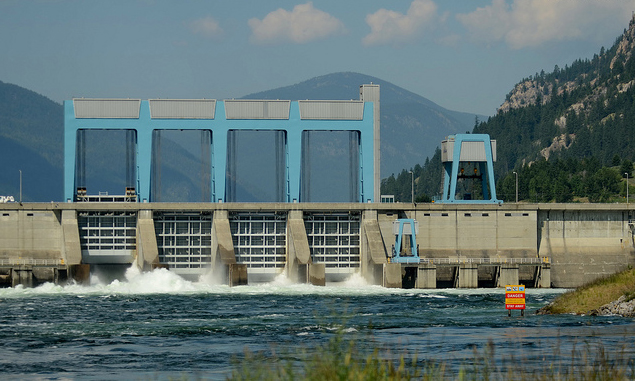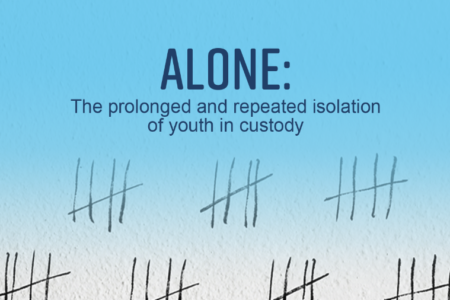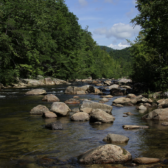Dams, Nations and the Columbia River Treaty
Since 2005, Eileen Delehanty Pearkes has researched and explored the natural and human history of the rivers of the upper Columbia River Basin.
She speaks frequently at conferences and symposia throughout the Basin on the history of the Columbia River Treaty and its effects on Basin residents. She has recently completed a manuscript titled A River Captured – history and hydro-electricity in the upper Columbia Basin.
An American by birth, Pearkes has been a resident of Canada since 1985 and Nelson since 1994. She has written many articles and several books that explore place and its cultural meaning.
The Geography of Memory, a history of the landscape and indigenous people of the upper Columbia watershed published in 2002, remains a Kootenay classic.
Pearkes has agreed to help The Nelson Daily readers understand the importance of the Columbia River Treaty to the region with another edition of River Talk.
Today the Pearkes discusses the topic of one of the most controversial projects at the time of construction of the Columbia River Treaty, the Hugh Keenleyside Dam near Castlegar.
Of all the Columbia River Treaty projects, the most controversial at the time of construction was the High Arrow Dam, today known as Keenleyside Dam.
Located near Castlegar, B.C., the dam transformed the Arrow Lakes valley into a 150-mile long reservoir. This destroyed archaeological sites and fish habitats and displaced thousands of B.C. residents.
At the time of construction, Arrow dam had no power generators. It was never conceived as a power-producing facility, but instead was put in place for water storage. The CRT dictates that at the end of each winter, the Arrow reservoir must be emptied to make room for spring snow melt. This is part of the treaty’s assured flood control.
As last column explained, many flood control provisions will expire in 2024, at which point, if there are no new, detailed provisions added to the treaty through re-consideration or re-negotiation, river operations in Canada will revert to “called upon” status.
Both countries are currently positioning themselves about what “called upon” means, but one thing seems certain: Canada will be much freer in the operation of Arrow.
What might that mean for the Arrow Lakes valley?
For one answer, we can look back 40 years to the words of Gordon MacNabb – a chief CRT advisor to the Federal governments of Diefenbaker and Pearson. In 1974, MacNabb spoke at a lecture series sponsored by Simon Fraser University that marked the 10-year anniversary of the Treaty. In Canada, there was still controversy about the merits of the agreement. At the nexus of the debate were misgivings about the High Arrow project, fueled in part by residents of the Arrow Lakes valley, those who experienced daily the dramatic ecological and social consequences.
MacNabb was a young engineer at the time of the CRT signing, and today in his eighties, his memory and analysis remain sharp. He is a CRT elder, one who shares his invaluable perspective and knowledge at conferences and in government policy circles.
In his talk back in 1974, MacNabb said something that applies quite sharply to the present:
“Our commitment to operate the Arrow Lakes reservoir runs strictly for 60 years….we could just lower the level controlled by the Arrow Lakes dam down to what the normal water level in the lake is….capacity to store higher would always be there. But we could just lower the controlled level, and if you wanted you could reclaim all that land between Revelstoke and the head of the Arrow Lakes…we’re not tied in any way under the Treaty after 60 years.”
Though I underlined it heavily at the time, I have to admit that I had forgotten all about this paragraph until recently, when I began to hear murmurings among those engaged in Columbia River issues on both sides of the boundary. These murmurings involve not the lowering of water levels as MacNabb suggested, but the possibility of taking out Hugh Keenleyside Dam altogether.
Let me write that one more time.
Yes, taking out Hugh Keenleyside Dam.
Ten years ago, such an idea would have been met with guffaws or derision. But that was a decade ago! Today, dams are being removed all over North America. Fish and wildlife recovery is happening faster and more thoroughly than even science could have predicted. People are realizing that good things can happen for rivers when obstructions are removed. Those murmuring about Keenleyside come from various places on the political spectrum.
The formal CRT review engaged in by both countries over the past few years did not involve any formal discussion of dam removal. It did result, however, in a third concept beyond hydro-power efficiency and flood control, one that has measurable importance in today’s world: ecosystem function.
Murmurings in CRT circles about “taking out Keenleyside” are rising because of the potential ecosystem improvements that could come from either removing the dam entirely or, as MacNabb suggested presciently in 1974, operating it much differently.
Now that I have tossed this rather large rock into the CRT pond, I will let the ripples settle.
Next column will explore some of the pros and cons of Keenleyside removal or change in its operation.
Meanwhile, those who live in Nelson can watch a film produced in the U.S. about shifting perceptions of dams and their function. “Damnation” runs Wednesday Sept. 10 only, at the Civic Theatre.
Those who live in other parts of the basin can read about the film and where to download it.
See Previous Column.
See Previous Column.


























